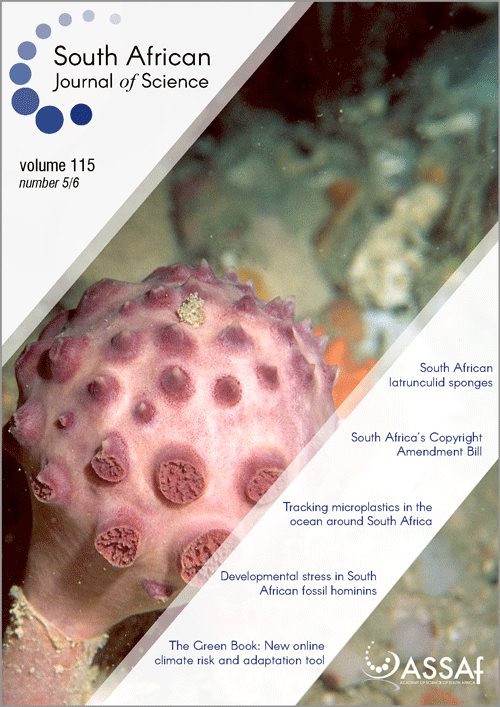The colourful chemistry of South African latrunculid sponges
DOI:
https://doi.org/10.17159/sajs.2019/5534Keywords:
marine sponges, Latrunculiidae, sponge taxonomy, marine alkaloids, bioactivityAbstract
Marine sponges – in common with many other sessile marine invertebrates seemingly devoid of obvious physical forms of defence against predators, e.g. spines or shells – are the sources of a diverse array of organic chemical compounds known as marine natural products or secondary metabolites. Recent research has indicated that the production of natural products via cellular secondary metabolic pathways in some sponge species may not occur within the sponge cells themselves, but rather in microbial endosymbionts which inhabit the surface and interstitial spaces within the sponge tissue. Regardless of their biosynthetic origin, the bioactivity, e.g. toxicity, of many of these marine natural products may be utilised by sponges as chemical feeding deterrents to discourage predation or to provide a chemical anti-fouling competitive edge in the intense competition for living space amongst filter-feeders on space-limited benthic reefs. Paradoxically, a small number of sponge natural products have serendipitously shown potential as new pharmaceuticals, e.g. novel anti-cancer drugs. Marine biodiscovery (or bioprospecting) is the search for new pharmaceuticals from marine organisms. Exploration of the taxonomy, natural products chemistry and biomedicinal potential of the rich diversity of South African latrunculid sponges (family Latrunculiidae), at Rhodes University, the South African Department of Environmental Affairs and the University of the Western Cape has continued unabated for over a quarter of a century as part of a collaborative marine biodiscovery programme. A short review of this multidisciplinary latrunculid sponge research is presented here.
Published
Issue
Section
License

All articles are published under a Creative Commons Attribution 4.0 International Licence
Copyright is retained by the authors. Readers are welcome to reproduce, share and adapt the content without permission provided the source is attributed.
Disclaimer: The publisher and editors accept no responsibility for statements made by the authors
How to Cite
- Abstract 1070
- PDF 947
- EPUB 204
- XML 444













.png)